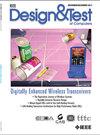Electronic Design Methods and Technologies for Green Buildings
引用次数: 0
Abstract
h BUILDINGS, INCLUDING HOMES, offices, and retail spaces, are amajor source of energy consumption and resources. As our society grapples with the high cost of fossil fuels, global warming, and climate change, ‘‘green buildings’’ have caught our imagination. Today, green buildings are a reality and they are driving a lot of concerted research and innovations in diverse fields that encompass design, construction, renovation, operation, maintenance, and demolition. The design and test community has addressed energy and resource optimization problems for integrated circuits and electronic systems for many years. It is, therefore, only natural that many of the design and optimization problems for green buildings can leverage technologies that we are familiar with, such as embedded computing, sensor networks, low-power design, and cyberphysical systems. In fact, electronics and computing systems can be viewed as a part of the problem (energy consumer), but also as part of the solution. This timely issue introduces Design and Test of Computers readers to the role that electronic design methods and technologies can play in the design of green buildings of the future. Design and test techniques can, therefore, migrate ‘‘up’’ from the ‘‘nano’’ and ‘‘micro’’ worlds of integrated circuits to the much larger scale of green buildings. Guest Editors Yuvraj Agrawal and Anand Raghunathan have taken the initiative and worked diligently to put together this special issue with a set of selected articles, which include contributions by experts and active researchers who can relate to design and test technologies. These articles cover the landscape of research advances, practical experiences, and perspectives on future trends. The special issue covers control systems for energy management, occupancy driven HVAS systems for heating and cooling, energy minimization of HVAC systems using prediction, innovations in sensing and actuation for energyefficiency, and the use of a distributed network of embedded computers for building automation and control system design. Readers will also find two perspectives articles from visionaries in this field. The first article highlights the promise of software-defined buildings, where a building can incorporate operating systems on which applications can be built. The second perspectives column describes a sensors-based substrate that can provide measurements to guide sustainable choices by building users. I thank Yuvraj and Anand for serving as Guest Editors of the special issue, the authors for their contributions, and the reviewers for their adherence to an extremely tight review schedule. I also thank the column editors for their contributions. I hope you will enjoy reading this special issue, as well as the subsequent issues of Design and Test of Computers in 2012. We have lined up an exciting set of special issues for the remainder of 2012 and for the first half of 2013. We are now preparing the lineups for the remaining issues of 2013. Inputs and participation from theDesign and Test of Computers readership are always welcome!绿色建筑的电子设计方法与技术
h建筑,包括住宅、办公室和零售空间,是能源消耗和资源的主要来源。随着我们的社会与化石燃料的高成本、全球变暖和气候变化作斗争,“绿色建筑”引起了我们的想象。如今,绿色建筑已经成为现实,它们正在推动包括设计、建造、改造、运营、维护和拆除在内的各个领域的大量协同研究和创新。多年来,设计和测试界一直致力于集成电路和电子系统的能源和资源优化问题。因此,绿色建筑的许多设计和优化问题可以利用我们熟悉的技术,如嵌入式计算、传感器网络、低功耗设计和网络物理系统,这是很自然的。事实上,电子和计算系统可以被看作是问题(能源消耗)的一部分,但也是解决方案的一部分。本期《计算机设计与测试》向读者介绍了电子设计方法和技术在未来绿色建筑设计中的作用。因此,设计和测试技术可以从集成电路的“纳米”和“微观”世界“向上”迁移到更大规模的绿色建筑中。特邀编辑Yuvraj Agrawal和Anand Raghunathan采取了主动和勤奋的工作,将这期特刊与一系列精选文章组合在一起,其中包括与设计和测试技术相关的专家和活跃研究人员的贡献。这些文章涵盖了研究进展、实践经验和对未来趋势的看法。本期特刊涵盖了能源管理控制系统、用于供暖和制冷的占用驱动HVAS系统、利用预测实现暖通空调系统的能源最小化、节能传感和驱动方面的创新,以及用于建筑自动化和控制系统设计的嵌入式计算机分布式网络的使用。读者还将发现来自该领域的远见者的两篇观点文章。第一篇文章强调了软件定义的建筑的前景,在这种建筑中,一个建筑可以包含可以在其上构建应用程序的操作系统。第二个观点专栏描述了一个基于传感器的基板,它可以提供测量,以指导建筑用户做出可持续的选择。我感谢Yuvraj和Anand担任特刊的客座编辑,感谢作者们的贡献,感谢审稿人们严格遵守严格的审稿时间表。我还要感谢专栏编辑们的贡献。我希望你会喜欢阅读这一期特刊,以及2012年的《计算机设计与测试》。我们为2012年剩余时间和2013年上半年准备了一系列令人兴奋的特刊。我们现在正在准备2013年剩余问题的阵容。欢迎来自《计算机设计与测试》读者的输入和参与!
本文章由计算机程序翻译,如有差异,请以英文原文为准。
求助全文
约1分钟内获得全文
求助全文

 求助内容:
求助内容: 应助结果提醒方式:
应助结果提醒方式:


